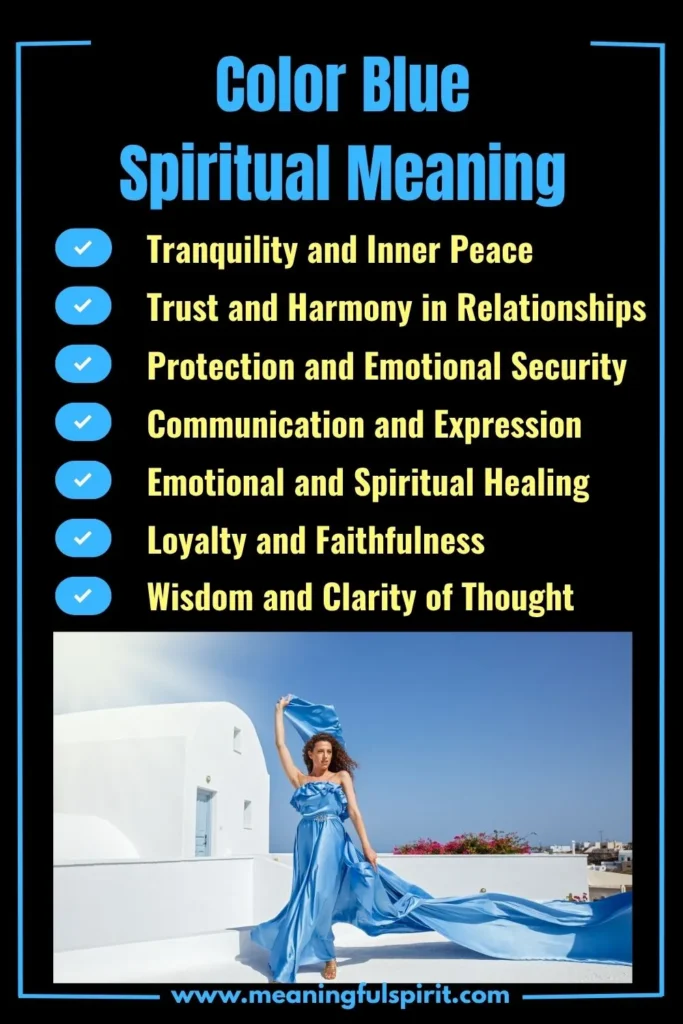Spiritual Meanings of Color Blue, Symbolism & Psychology

The color blue is one of the most widely recognized and loved colors around the world. Whether it’s the vastness of the sky, the depth of the oceans, or the gentle hues of twilight, blue evokes powerful emotions and has deep spiritual meanings.
But what does it truly symbolize in life, dreams, and belief systems? This blog dives into the captivating spiritual meanings, psychological insights, and cultural symbolism of the color blue.
What Does the Color Blue Represent?
The color blue often represents calmness, stability, and trust. It is associated with serene environments and peaceful states of mind. This makes blue a color that frequently symbolizes emotional balance and mental clarity. For many, seeing blue can feel like stepping into a calm environment, giving them a moment of relief and introspection.
Blue is also deeply tied to notions of loyalty, reliability, and authority. This is why organizations, businesses, and even uniforms often feature the color in their branding—it encourages feelings of trust and dependability. On a more personal level, people often associate blue with wisdom and intuition, representing the pursuit of truth and understanding.
On a spiritual level, the color blue connects individuals with the infinite expanse of the sky and ocean, both of which symbolize mystery and boundless possibilities. The openness of the color can inspire journeys of self-discovery and personal growth.
Psychological Meanings of the Color Blue
From a psychological standpoint, blue is known to have a soothing effect on the mind and body. It can reduce stress, lower blood pressure, and promote relaxation. This is why blue is often used in spaces such as bedrooms or therapeutic environments to create a tranquil atmosphere.
However, not all shades of blue have the same psychological impact. Lighter shades, such as baby blue, are often seen as fresh and invigorating, inspiring a sense of hope and new beginnings. Deeper blues, like navy or midnight blue, are associated with seriousness, professionalism, and wisdom. These shades tend to evoke feelings of introspection and concentration.
Yet, blue isn’t all about calmness. Excessive exposure to blue can sometimes evoke feelings of sadness or detachment, which is where sayings like “feeling blue” originate. Despite its calming properties, this duality is an important psychological characteristic of the color.
12 Spiritual Meanings of Blue Color

1. Blue Color Represents Tranquility and Inner Peace
Blue is a symbol of peace and emotional balance, often associated with calming the mind. It’s a color that can help individuals relax and let go of stress.
Spiritually, blue is frequently used in practices like meditation to create a tranquil atmosphere. It helps people silence the mental noise and find their inner calm.
The soothing energy of blue promotes a sense of well-being, making it ideal for spaces where people seek relaxation. Its calming influence supports emotional stability and harmony in daily life.
By surrounding yourself with blue, you invite peace into your environment. Whether through visual art, light, or clothing, this color helps create a serene space for emotional healing.
2. Blue Color Builds Trust and Harmony in Relationships
Blue is often linked to trust, making it a vital color in spiritual and personal relationships. It strengthens the bond between people by encouraging honesty.
This color represents the reliability and dependability that foster healthy connections. By incorporating blue, individuals can nurture trust in both personal and professional relationships.
Spiritually, blue is said to align with harmony, helping to resolve conflicts and build mutual understanding. It promotes open communication and emotional safety between individuals.
Whether in friendships or partnerships, blue invites a sense of loyalty and transparency. Its calming tone ensures that relationships thrive on trust and genuine connection.
3. Blue Color Offers Protection and Emotional Security
Blue has long been regarded as a protective color, acting as a spiritual shield against negativity. It creates a feeling of safety and emotional comfort.
Many believe that blue wards off harmful energies, offering peace of mind in challenging situations. It is a color often visualized during protective meditations.
The spiritual essence of blue extends to creating boundaries, shielding individuals from emotional harm. This protection allows people to feel more secure and grounded in their daily lives.
In moments of vulnerability, blue serves as a reminder of inner strength. Its protective nature encourages individuals to face challenges with courage and resilience.
4. Blue Color Improves Communication and Expression
Blue is a color tied to clear and honest communication, supporting individuals in expressing themselves authentically. It aligns with clarity in speech and thought.
This color promotes transparency, encouraging people to share their feelings and ideas freely. Spiritually, it resonates with the throat chakra, which governs expression.
Blue helps individuals find the right words to convey their emotions and intentions. It fosters open dialogue, strengthening relationships through better understanding.
By embracing blue, people can enhance their confidence in communication. Whether in personal or professional settings, it ensures meaningful and effective interactions.
5. Blue Color Provides Emotional and Spiritual Healing
Blue is widely recognized as a healing color, offering comfort during times of emotional pain or stress. It soothes the heart and mind, creating a space for recovery.
Spiritually, blue is associated with divine healing energies that bring relief to both body and soul. It is used in practices like color therapy to promote overall well-being.
The calming presence of blue helps individuals process difficult emotions and move toward acceptance. Its energy supports emotional release and peaceful restoration.
Whether dealing with loss or anxiety, blue offers a sense of hope and renewal. It serves as a gentle reminder that healing is possible, even in tough times.
6. Blue Color Reflects Loyalty and Faithfulness
Loyalty and faithfulness are strongly tied to the color blue, symbolizing commitment in relationships and spiritual practices. Blue fosters trust and dependability.
It inspires individuals to remain true to their values and promises, enhancing personal integrity. This loyalty extends to friendships, partnerships, and even one’s spiritual journey.
Blue also signifies devotion to higher ideals and purpose. It encourages people to stay committed to their goals and relationships, even in difficult times.
By embracing blue, individuals are reminded of the importance of being faithful and reliable. It strengthens bonds and fosters long-lasting connections.
7. Blue Color Represents Connection to the Divine
Blue is often associated with the heavens, symbolizing a connection to divine wisdom and higher powers. It represents spirituality and enlightenment.
This color helps individuals deepen their relationship with the universe and their sense of purpose. Blue is seen as a bridge between earthly existence and the divine realm.
Many spiritual teachings link blue to the pursuit of inner peace and understanding, aligning the soul with higher truths. It encourages introspection and spiritual growth.
By meditating on blue, individuals can access their inner wisdom and divine guidance. It serves as a portal to greater spiritual awareness and serenity.
8. Blue Color Embodies Wisdom and Clarity of Thought
Wisdom and intellectual clarity are closely tied to blue, representing the pursuit of knowledge and truth. It supports logical thinking and decision-making.
Blue helps individuals cut through confusion, allowing them to focus on what truly matters. Its calming energy ensures a clear mindset, even in challenging situations.
Spiritually, blue encourages the search for deeper understanding and enlightenment. It aligns the mind with higher truths, fostering personal growth and insight.
Whether in academics or spiritual practice, blue inspires clarity and wisdom. It reminds individuals to seek knowledge and approach life’s challenges with an open mind.
9. Blue Color Symbolizes Spiritual Journey and Self-Discovery
Blue represents the exploration of inner mysteries and the pursuit of self-awareness. It inspires individuals to embark on their spiritual journeys with courage.
This color encourages introspection, helping people uncover their true selves and purpose. It aligns with the soul’s quest for growth and transformation.
The journey symbolized by blue is one of learning, healing, and finding balance. It reminds individuals to trust the process and embrace their unique path.
By embracing blue, individuals are guided toward self-discovery and spiritual fulfillment. It serves as a beacon of hope and renewal along life’s journey.
10. Blue Color Encourages Mental Clarity and Focus
Blue is a color that fosters mental clarity, helping individuals focus on their priorities and goals. It clears away distractions and promotes a sense of purpose.
This clarity ensures that people can approach life with a calm and steady mindset. Blue encourages thoughtful decision-making and problem-solving.
On a spiritual level, blue helps individuals align their thoughts with their higher purpose. It supports mindful practices that bring clarity to one’s life direction.
By surrounding themselves with blue, people can achieve a greater sense of focus. It allows them to tackle challenges with confidence and precision.
11. Blue Color Helps Cultivate Patience and Calmness
Blue is often associated with patience and calmness, promoting resilience in stressful situations. It encourages people to remain composed and centered.
This color serves as a reminder to slow down and approach life’s challenges with grace. It fosters a sense of peace that helps individuals navigate difficult moments.
Spiritually, blue is tied to the practice of mindfulness, teaching people to embrace the present moment. It cultivates an inner strength that allows for patience and understanding.
By embracing blue, individuals can develop a deeper sense of calm. It empowers them to handle stress with a steady and composed attitude.
12. Blue Color Promotes Serenity and Inner Peace
Serenity is one of the most profound meanings of blue, offering a sense of inner peace amidst life’s chaos. It encourages individuals to pause and reflect.
This color creates a calming atmosphere, reminding people to seek balance and harmony. It fosters a sense of tranquility that supports emotional well-being.
Spiritually, blue aligns with the energy of peace and contentment. It helps individuals find solace in their daily lives, no matter the circumstances.
By embracing blue, people can create a peaceful environment that nourishes the soul. It serves as a reminder to prioritize self-care and inner calm.
Different Shades of Blue and Their Spiritual Significance
Blue is a deeply spiritual color, with each shade carrying its own unique meaning. Light blue is often linked to feelings of peace and serenity. It represents hope and innocence, making it a symbol for fresh starts or spiritual awakenings. This soft shade encourages a calming presence, opening the mind to new possibilities and emotional balance.
Sky blue, as its name suggests, reminds us of the limitless sky above. It represents freedom and boundless imagination, inviting people to expand their creative potential. This shade is often connected to inspiration, encouraging individuals to dream and think beyond their limitations. Sky blue serves as a reminder of infinite possibilities and a connection to the divine.
The richness of royal blue carries connotations of power and divine protection. This bold shade is associated with the strength to overcome obstacles and safeguard one’s spiritual journey. It is often seen as a color of leadership and authority, reminding us to embrace inner power. Royal blue acts as a shield of spiritual security and confidence.
In contrast, navy blue embodies wisdom, structure, and order. This deep shade encourages reflection and a sense of discipline in life’s pursuits. Navy blue is particularly tied to inner strength and the pursuit of deeper knowledge, making it a color that supports spiritual maturity. It reminds individuals to find balance and trust in their personal growth.
Finally, turquoise blends the calming qualities of blue with the growth-oriented energy of green. This vibrant shade is often associated with communication and emotional healing. Turquoise invites clarity in self-expression and supports the journey toward emotional and spiritual transformation. Through its dual nature, this color bridges the mind and the heart, fostering inner harmony.
Blue’s Spiritual Role in Different Cultures and Religions
The color blue carries spiritual significance across various cultural and religious contexts. In Hinduism, blue is revered as the color tied to Lord Krishna, a deity known for divine love and protection. His blue skin symbolizes an infinite connection to the universe and an embodiment of compassion. Blue in Hindu culture represents the divine presence in everyday life, encouraging humility and devotion.
In Christianity, blue is frequently associated with the Virgin Mary, representing purity, faith, and humility. It reflects a reverence for the divine and the human capacity for spiritual obedience. The color is often used in religious art to symbolize trust in divine guidance and the sacred role of nurturing grace.
In Middle Eastern traditions, blue is a protective color, commonly seen in talismans like the Evil Eye. This belief in blue’s ability to ward off negative energy highlights its role as a guardian against harmful influences. It reflects the cultural understanding that spiritual protection can shield individuals from external harm.
For the Ancient Egyptians, blue was connected with the heavens and divine protection. It symbolized eternal life and cosmic power, often featured in artifacts and religious symbols. The Egyptians viewed blue as a sacred bridge between the mortal world and the divine, offering guidance and safety.
Blue’s Biblical Spiritual Symbolism and Significance
In the Bible, the color blue holds profound spiritual meaning. It is often associated with heavenly realms and divine purity. Blue appears in descriptions of sacred spaces, such as the Tabernacle, highlighting its connection to God’s presence. It serves as a reminder of the divine’s proximity and the purity required to approach it.
This color is also linked to obedience to divine law. In scripture, blue was used in the garments of priests, symbolizing their service to God and their commitment to righteousness. It encourages believers to live a life aligned with spiritual principles and moral clarity.
Blue’s association with spiritual understanding is further reflected in religious artifacts and rituals. It represents an invitation to deepen one’s connection with the divine and seek higher awareness. Through its biblical context, the color blue inspires a sense of trust, devotion, and spiritual purpose.
Spiritual Interpretations of Blue in Dreams
Seeing the color blue in dreams often carries significant spiritual messages. For example, clear blue skies in dreams are symbolic of hope and future opportunities. These dreams encourage individuals to focus on positivity and trust in the path ahead, as it suggests a time of spiritual renewal.
If one dreams of blue water, it often reflects emotional healing and self-discovery. These visions signal the start of a period of cleansing and reconnection with oneself. Blue water in dreams can also serve as a reminder to find calm amidst emotional turbulence.
In contrast, darker shades of blue in dreams suggest the need for introspection and growth. They may indicate a time to reflect on personal values and relationships, urging individuals to explore deeper layers of their spiritual journey. These dreams often act as a call for greater mindfulness and self-awareness.
Connection Between Blue and Throat Chakra in Spiritual Practices
In spiritual practices, the color blue is closely tied to the throat chakra, also known as Vishuddha. This chakra governs communication, truth, and self-expression, making it essential for authentic interactions. When the throat chakra is balanced, individuals can speak their truth with clarity and confidence, building stronger connections.
A blocked throat chakra can lead to issues in communication or feelings of being unheard. Meditating on the color blue or wearing blue tones can help restore harmony in this chakra. By focusing on blue, individuals can realign their energy, fostering honest and open self-expression.
The connection between blue and the throat chakra also highlights the importance of speaking with integrity. This chakra encourages individuals to be mindful of their words and embrace the power of communication in their spiritual growth. Through this practice, the color blue fosters a sense of trust and inner peace.
You Might Also Like
1)
2)
3)
4)
5)









